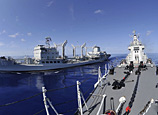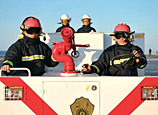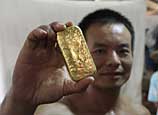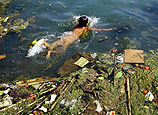
WASHINGTON, June 6 (Xinhua) -- An international team of researchers reported Thursday they have discovered an intriguing clue that could help solve a long-standing mystery about how dust particles grow to larger sizes so that they can eventually form planets.
By imaging the outer regions of a young solar system known as Oph IRS 48, which resides approximately 390 light-years from our Earth, astronomers have discovered a crescent-shaped structure known as a "dust trap." The researchers speculate that this newly discovered feature is actually a protective cocoon where the critical early steps of planet formation can take place.
Astronomers now know that planets around other stars are plentiful, but when they try to model the evolution of dust grains into pre-planetary bodies, such as pebbles and boulders, they run into a problem. Once dust grains grow to a certain size, they tend to self-destruct, either by colliding with other grains or by being drawn into their central star.
"There is a major hurdle in the long chain of events that leads from tiny dust grains to planet-sized objects," said Til Birnstiel, a researcher at the Harvard-Smithsonian Center for Astrophysics, and co-author on the paper published in the journal Science.
"In computer models of planet formation, dust grains must grow from submicron sizes to objects up to ten times the mass of the Earth in just a few million years. But once particles grow larger enough, they begin to pick up speed and either collide, sending them back to square one, or slowly drift inward, thwarting further growth," Birnstiel said in a statement.
To save dust grains from this fate, astronomers have proposed that a vortex, essentially a "bump" in the disk, would produce a region known as dust trap that enable dust particles to cling together, eventually setting the stage for the formation of larger and larger objects.
Creating the dust trap, however, requires the helping hand of a very large object, such as a gas-giant planet or companion star. As this secondary object plows through the disk, it would clear a path around the star and produce the essential eddies and vortices in its wake, the researchers said.
Previous studies of Oph IRS 48 revealed a very uniform ring of carbon monoxide gas and small dust grains around the star, with no hints of a theorized dust trap. They did, however, detect a large gap between the inner and outer portions of the disk, which is a likely telltale sign that a very massive planet, about 10 Jupiter masses, or a companion star was present. Such an object could produce the necessary conditions for a dust trap.
Using the new Atacama Large Millimeter/submillimeter Array ( ALMA) telescope, the researchers were now able to simultaneously observe both the gas and the much larger dust grains, revealing something the other telescopes could not: a lopsided bulge in the outer portion of the disk.
"At first the shape of the dust in the images was a complete surprise for us," said lead author Nienke van der Marel of the Leiden Observatory in the Netherlands in a statement.
"Instead of the ring we had expected to see, we found a very clear cashew-nut shape. We had to convince ourselves that this feature was real, but the strong signal and sharpness of the ALMA observations left no doubt about the structure," said van der Marel.
Though the ALMA observations revealed only the outer structure of the disk, at more than 50 times the distance of the Earth to the Sun, the principle would still be the same closer to the star where rocky planets would form, the researchers said.
"This structure we see with ALMA could be scaled down to represent what may be happening in the inner solar system where more Earth-like rocky planets would form," said Birnstiel. "In the case of these observations, however, we may be seeing something analogous to the formation of our Sun's Kuiper Belt or Oort Cloud, the region of our solar system where comets are believed to originate."
















 Breathing and Working Together:Mobile app tells you Beijing's environment
Breathing and Working Together:Mobile app tells you Beijing's environment


![]()
